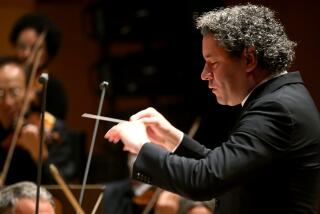MUSIC : Out of Sequence, It Still Adds Up to Beethoven
- Share via
If music weren’t so mathematical, a person might suspect that the great Beethoven had some trouble with numbers.
He wrote four overtures for his sole opera. Three of them bear numbers in their titles, but the numbers don’t indicate the order in which they were written.
The “Leonore” Overture No. 2 was actually the first. The “Leonore” Overture No. 3 was really the second. The “Leonore” No. 1 was the third.
Fortunately, by the time he got to writing the fourth, he had changed the name of the opera to “Fidelio,” so that overture bears that name in the title.
Similarly, Beethoven’s Piano Concerto No. 2, which Robert Thies will play with Ami Porat and the Mozart Camerata on Sunday, was written before what is known as the Piano Concerto No. 1. It was just published later. . . .
The Second Concerto, said Thies, a 23-year-old piano student at USC, “almost looks back to Mozart. But you have to make it not sound like Mozart, but like Beethoven.”
“It’s certainly not the tragic Beethoven that I saw in the Third Concerto that I played with Ami last year. At the same time, it shows many faces of Beethoven. “It’s not tragic, but the Second Movement is certainly one of his most tender compositions. It’s quite beautiful, and it offers a big contrast to just what preceded it and what is going to succeed it as well. There are completely different moods.”
On the whole, Thies said, “I would describe the work as very pastoral.”
“You can tell Beethoven looks to nature for inspiration. They always talk about Beethoven roaming about the woods with his sketchbook. The Third Movement is based around the motif of the cuckoo bird. But he has bird calls in the first movement as well.”
Technically, however, “the Second Concerto is more difficult than the Third,” he added. That might be because in his early days in Vienna, Beethoven was basically making a name for himself as a pianist and improviser as well as a composer, and probably he wanted something virtuosic to draw attention to his talents.
“I’ve heard that from other pianists too,” Thies said. “It’s hard because of the passage work. And musically you have a responsibility, as well.”
Who: Pianist Robert Thies with conductor Ami Porat and the Mozart Camerata.
When: Sunday, April 10, at 4 p.m.
Where: St. Andrew’s Presbyterian Church, 600 St. Andrews Road, Newport Beach.
Whereabouts: Take the Costa Mesa (55) Freeway south until it turns into Newport Boulevard and proceed to 15th Street, turn left, then turn right at St. Andrews Road. St. Andrew’s is in the first block, on the left.
Wherewithal: $14 to $29. ($7 for student rush.)
Where to call: (714) 631-2233.
More to Read
The biggest entertainment stories
Get our big stories about Hollywood, film, television, music, arts, culture and more right in your inbox as soon as they publish.
You may occasionally receive promotional content from the Los Angeles Times.










